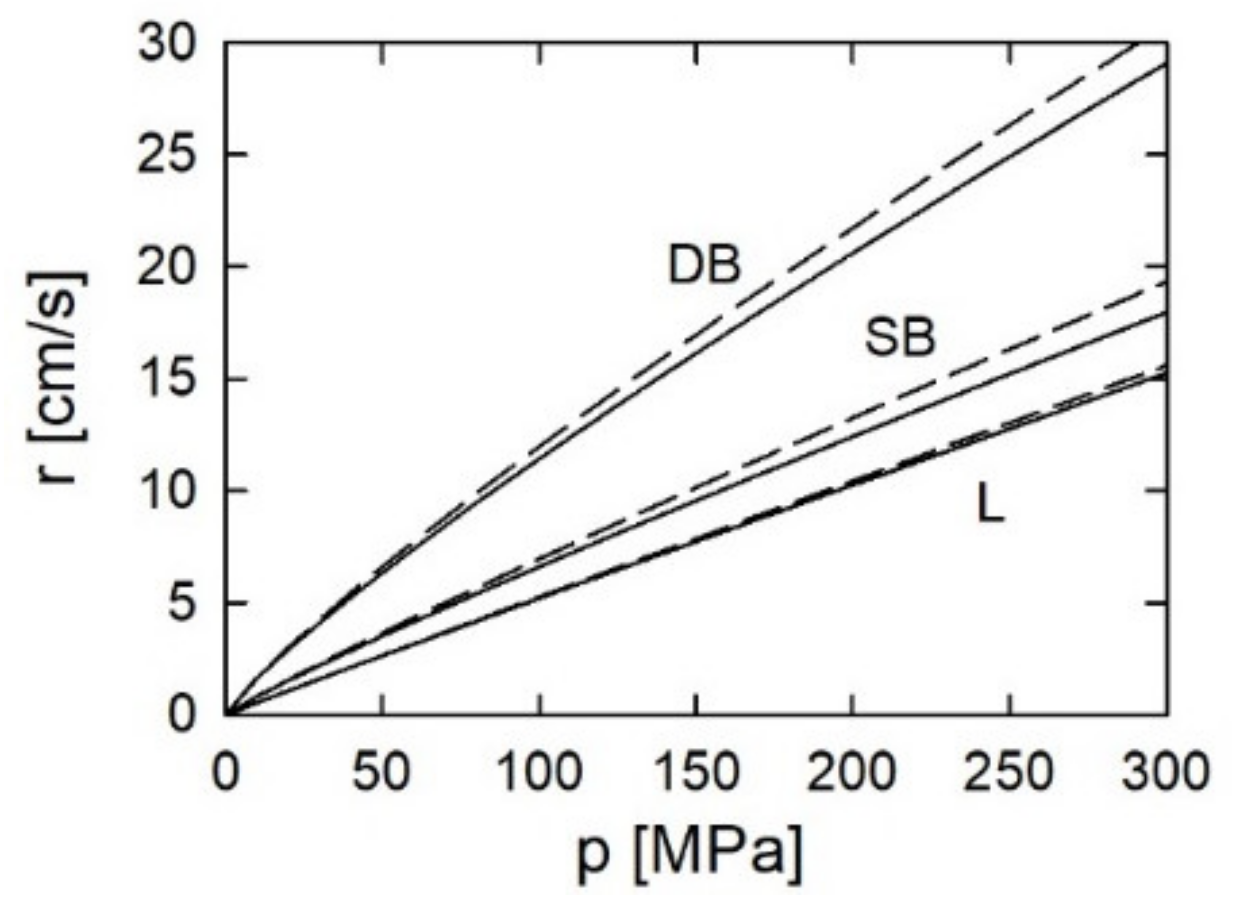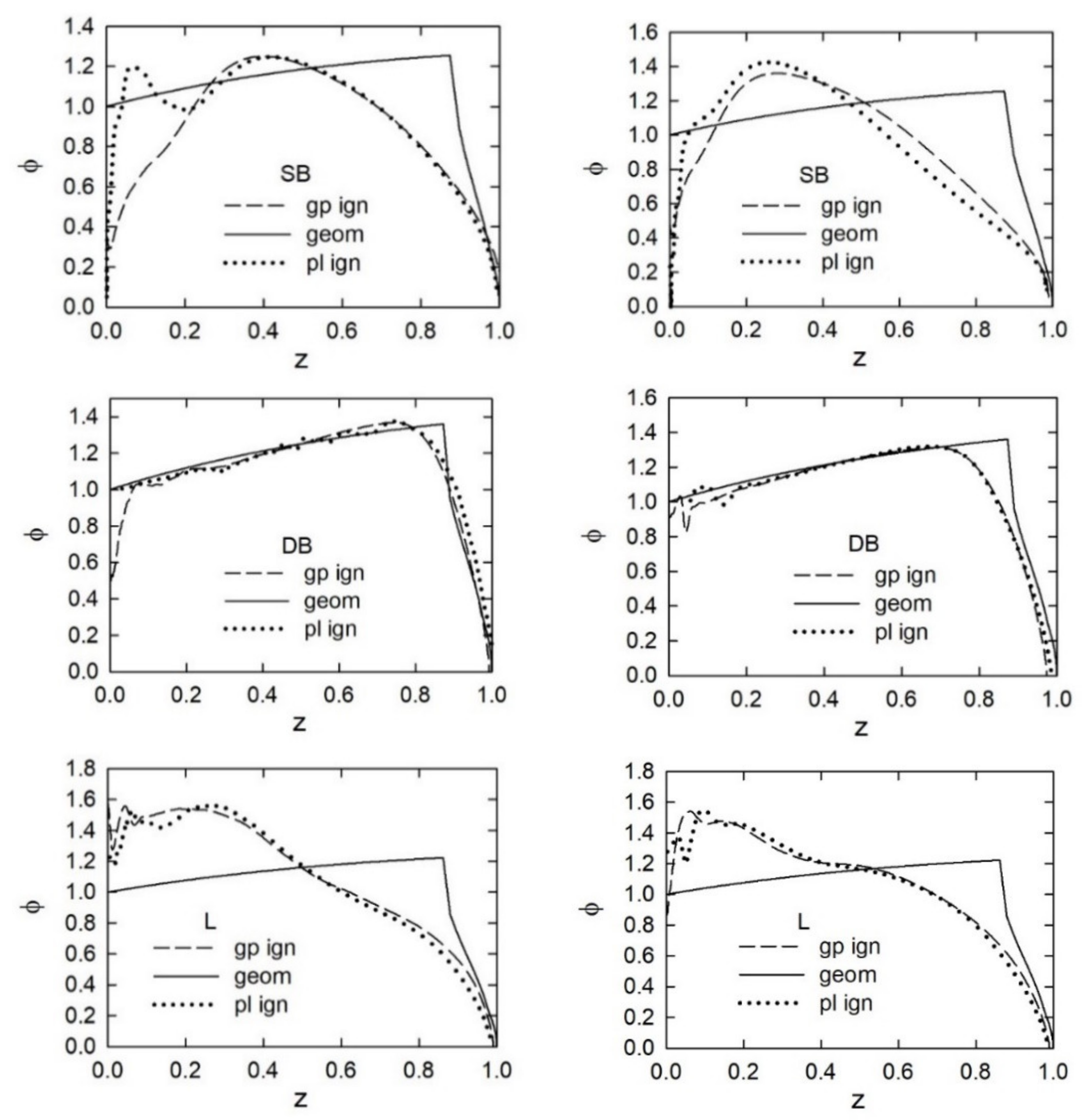Analysis of Application of Plasma Ignition in Closed Vessel Tests
Abstract
1. Introduction
2. Materials and Methods
3. Results and Discussion
4. Conclusions
- (1)
- The results from the analysis suggest that propellant characteristics determined in closed vessel tests for gunpowder ignition and plasma jet ignition differ. However, the differences are not large.
- (2)
- The application of plasma jet ignition is recommended for determining the burning rate at low values of pressure. In the case of gunpowder ignition, parallel burning of the gunpowder and a tested propellant considerably influences the rate.
- (3)
- Discharge energy should be fitted to the tested propellant. Higher values of the energy are necessary in the case of fine grains.
- (4)
- Contrary to expectations, the use of plasma jet ignition does not eliminate differences between the theoretical and experimental shape function for single-base and LOVA propellants. This proves that the differences cannot be explained by the influence of the ignition.
Author Contributions
Funding
Institutional Review Board Statement
Informed Consent Statement
Data Availability Statement
Conflicts of Interest
References
- Van Driel, C.A. Ignition Behaviour of LOVA Propellant. In Proceedings of the 24th International Symposium on Ballistics, New Orleans, LA, USA, 22–26 September 2008; pp. 258–264. [Google Scholar]
- Baschung, B.; Bouchama, A.; Comet, M.; Boulnois, C. Experimental Investigation of Different Ignition Methods for LOVA Gun Propellant. In Proceedings of the 28th International Symposium on Ballistics, Atlanta, GA, USA, 22–26 September 2014; pp. 532–541. [Google Scholar]
- Boulnois, C.; Baschung, B.; Bouchama, A.; Comet, M.; Mura, D.; Steinbach, C. Experimental Characterization of the Energy Transferred from an Igniter Based on Nanothermites to the Propellant Bed. In Proceedings of the 27th International Symposium on Ballistics, Freiburg, Germany, 22–26 April 2013; pp. 38–49. [Google Scholar]
- Bach, A.; Eisenreich, N.; Neiger, M. Charakterisierung eines Plasma-Jets mit optischen und spektroskopischen Methoden. In Proceedings of the 22nd International Annual Conference of ICT, Karlsruhe, Germany, 2–5 July 1991; pp. 1–10. [Google Scholar]
- Powell, J.D.; Zielinski, A.E. Capillary Discharge in the Electrothermal Gun. IEEE Trans. Magn. 1993, 29, 591–596. [Google Scholar] [CrossRef]
- Woodley, C.R.; Fuller, S. Apparent Enhanced Burn Rates of Solid Propellants Due to Plasmas. In Proceedings of the 16th International Symposium on Ballistics, San Francisco, CA, USA, 23–27 September 1996; pp. 153–162. [Google Scholar]
- Proud, W.G.; Bourne, N.K. The Electrothermal Enhancement of Propellant Burning by Plasma Injection. Propellants, Explos. Pyrotech. 1997, 22, 212–217. [Google Scholar] [CrossRef]
- Grune, D.; Hensel, D. Combustion Behaviour of LOVA-Solid-Propellant by Ignition with Hot Plasma Gases and its Influence on the Interior Ballistic Cycle. In Proceedings of the 17th International Symposium on Ballistics, Midrand, South Africa, 23–27 March 1998; pp. 359–366. [Google Scholar]
- Oberle, W.F.; Wren, G.P. Radiative and Convective Heat Loss in Electrothermal-Chemical (ETC) Closed Chambers. In Proceedings of the 35th JANNAF Combustion Subcommittee Meeting, Tucson, AZ, USA, 7–11 December 1998; pp. 229–236. [Google Scholar]
- Woodley, C.R.; Saveli, G.E. Modelling Enhanced Gas Generation Rates in a 155 mm ETC Gun. In Proceedings of the 18th International Symposium on Ballistics, San Antonio, TX, USA, 15–19 November 1999; pp. 285–292. [Google Scholar]
- Kooker, D.E. A Mechanism for TEC-Augmented Burning Rate of Solid Propellant Consistient with Closed Chamber Experiments. In Proceedings of the 18th International Symposium on Ballistics, San Antonio, TX, USA, 15–19 November 1999; pp. 236–243. [Google Scholar]
- Powell, J.D.; Thornhill, L.; Batteh, J.H.; Verdon, M. Current distribution and resistance characteristics in plasma injectors for electrothermal-chemical launch. IEEE Trans. Magn. 1999, 35, 218–223. [Google Scholar] [CrossRef]
- Birk, A.; Del Guercio, M.; Kinkennon, A.; Kooker, D.E.; Kaste, P.J. Interrupted-Burning Tests of Plasma-Ignited JA2 and M30 Grains in a Closed Chamber. Propellants Explos. Pyrotech. 2000, 25, 133–142. [Google Scholar] [CrossRef]
- Taylor, M.J.; Woodley, C.R. Variation in Enhanced Gas Generation Rates in Electrothemal-Chemical Closed Chamber Studies. In Proceedings of the 19th International Symposium on Ballistics, Interlaken, Switzerland, 7–11 May 2001; pp. 179–186. [Google Scholar]
- Lombard, J.M.; Baschung, B.; Grune, D.; Carriere, A.; Andre, P. Analysis of ETC or Classical Manometric Closed vessel tests with Coupling of Thermodynamic Equilibrium Calculations: Combustion Rates, Energy Losses. In Proceedings of the 19th International Symposium on Ballistics, Interlaken, Switzerland, 7–11 May 2001; pp. 171–178. [Google Scholar]
- Koleczko, A.; Ehrhardt, W.; Schmid, H.; Kelzenberg, S.; Eisenreich, N. Plasma Ignition and Combustion. In Proceedings of the 19th International Symposium on Ballistics, Interlaken, Switzerland, 7–11 May 2001; pp. 195–202. [Google Scholar]
- Lombard, J.M.; Baschung, B.; Carrière, A.; André, P. Modelling of Classical and ETC Manometric Closed Vessel Tests. In Proceedings of the 34th International Conference of Institute Chemistry Technology, Pfinztal, Germany; 2003. [Google Scholar]
- Beyer, R.A.; Pesce-Rodriguez, R.A. The Response of Propellants to Plasma Radiation. IEEE Trans. Magn. 2005, 41, 344–349. [Google Scholar] [CrossRef]
- Akahoshi, Y.; Kitagawa, J.; Koura, T.; Fukushige, S.; Tadaoka, M. Development and Evaluation of a TSLGG—Application of an ETC Gun System to its First Stage. IEEE Trans. Magn. 2006, 43, 279–283. [Google Scholar] [CrossRef]
- Porwitzky, A.J.; Keidar, M.; Boyd, I.D. On the Mechanism of Energy Transfer in the Plasma–Propellant Interaction. Propellants, Explos. Pyrotech. 2007, 32, 385–391. [Google Scholar] [CrossRef]
- Xiao, Z.; Xue, A.; Ying, S.; He, W.; Xu, F.; Hou, B. Experimental Studies of Propellant Loading Parameters and Plasma Flow-Field Interactions. IEEE Trans. Magn. 2009, 45, 514–517. [Google Scholar] [CrossRef]
- Trebinski, R.; Leciejewski, Z.; Surma, Z.; Michalski, J. Comparative Analysis of Effects of Gunpowder and Plasma Ignitions in Closed Vessel Tests. Def. Technol. 2019, 15, 668–673. [Google Scholar] [CrossRef]
- Brish, A.A.; Galeev, I.A.; Zaitsev, B.N.; Sbitnev, E.A.; Tatarintsev, L.V. Mechanism of initiation of condensed explosives by laser radiation. Combust. Explos. Shock. Waves 1969, 5, 326–328. [Google Scholar] [CrossRef]
- Austin, W.; Barrows, A.W.; Forch, B.E.; Richard, A.; Beyer, R.A.; Cohen, A.; Newberry, J.E. Laser Ignition in Guns, Howitzers and Tanks: The LIGHT Program; Report ARL-TR-62; US Army Research Laboratory, Aberdeen Proving Ground: Aberdeen, MD, USA, 1993. [Google Scholar]
- Beyer, R.A.; Hirlinger, J.M. Laser Ignition in a Medium-Caliber Gun: A Study of Igniter Influence on Action Time; Report ARL-TR-1864; US Army Research Laboratory, Aberdeen Proving Ground: Aberdeen, MD, USA, 1999. [Google Scholar]
- Herreros, D.N.; Fang, X. Laser ignition of elastomer-modified cast double-base (EMCDB) propellant using a diode laser. Opt. Laser Technol. 2017, 89, 21–26. [Google Scholar] [CrossRef][Green Version]
- Churchyard, S.; Fang, X.; Vrcelj, R. Laser ignitibility of energetic crystals doped with gold nanoparticles. Opt. Laser Technol. 2019, 113, 281–288. [Google Scholar] [CrossRef]
- Courty, L.; Gillard, P.; Ehrhardt, J.; Baschung, B. Experimental determination of ignition and combustion characteristics of insensitive gun propellants based on RDX and nitrocellulose. Combust. Flame 2021, 229, 111402. [Google Scholar] [CrossRef]
- North Atlantic Council. STANAG 4115: Definition and Determination of Ballistic Properties of Gun Propellants, 2nd ed.; Military Agency for Standardization: Brussels, Belgium, 1997. [Google Scholar]
- Trebinski, R.; Leciejewski, Z.; Surma, Z. Modifications of the Closed Vessel Test Results Analysis Method. In Proceedings of the 31st International Symposium on Ballistics, Hyderabad, India, 4–7 November 2019. [Google Scholar]
- Carlucci, D.E.; Jacobson, S.S. Ballistics. Theory and Design of Guns and Ammunition; CRC Press: Boca Raton, FL, USA; London, UK; New York, NY, USA, 2008. [Google Scholar]
- Trębiński, R.; Leciejewski, Z.; Surma, Z. Investigations of the Influence of Ignition on the Dynamic Vivacity of Propellants. Probl. Mechatron. Armament Aviat. Saf. Eng. 2019, 9, 1–14. [Google Scholar] [CrossRef]
- Blackwood, J.D.; Bowden, F.P. The initiation, burning and thermal decomposition of gunpowder. Proc. R. Soc. Lond. Ser. A Math. Phys. Sci. 1952, 213, 285–306. [Google Scholar]
- Trębiński, R.; Janiszewski, J.; Leciejewski, Z.; Surma, Z.; Kamińska, K. On Influence of Mechanical Properties of Gun Propellants on Their Ballistic Characteristics Determined in Closed Vessel Tests. Materials 2020, 13, 3243. [Google Scholar] [CrossRef] [PubMed]






| Propellant | Grain Shape | Diameter [mm] | ½ Web Size [mm] | Perforation [mm] | Length [mm] | Specific Surface Area [m2/kg] |
|---|---|---|---|---|---|---|
| 5/7cfl (SB) | 7-perforated | 2.58 | 0.255 | 0.180 | 6.20 | 1.86 |
| JA-2 (DB) | 7-perforated | 8.78 | 0.893 | 0.546 | 14.15 | 0.52 |
| SC (L) | 7-perforated | 6.30 | 0.570 | 0.580 | 8.70 | 0.84 |
| Propellant | f [kJ/kg] (GPI) | f [kJ/kg] (PLI) | η [dm3/kg] (GPI) | η [dm3/kg] (PLI) |
|---|---|---|---|---|
| 5/7cfl (SB) | 811 | 806 (834) | 1.544 | 1.612 (1.531) |
| JA-2 (DB) | 919 | 853 (862) | 1.307 | 1.508 (1.518) |
| SC (L) | 882 | 843 (859) | 1.574 | 1.654 (1.629) |
| Propellant | n (PLI) | n (GPI) | β (PLI) | β (GPI) |
|---|---|---|---|---|
| 5/7 cfl (SB) | 0.91 ± 0.15 | 0.93 ± 0.10 | 0.100 ± 0.004 | 0.096 ± 0.003 |
| JA-2 (DB) | 0.85 ± 0.04 | 0.86 ± 0.09 | 0.228 ± 0.006 | 0.228 ± 0.006 |
| SC (L) | 0.98 ± 0.19 | 0.99 ± 0.11 | 0.057 ± 0.003 | 0.055 ± 0.004 |
Publisher’s Note: MDPI stays neutral with regard to jurisdictional claims in published maps and institutional affiliations. |
© 2021 by the authors. Licensee MDPI, Basel, Switzerland. This article is an open access article distributed under the terms and conditions of the Creative Commons Attribution (CC BY) license (https://creativecommons.org/licenses/by/4.0/).
Share and Cite
Trębiński, R.; Leciejewski, Z.; Surma, Z.; Michalski, J. Analysis of Application of Plasma Ignition in Closed Vessel Tests. Energies 2021, 14, 6377. https://doi.org/10.3390/en14196377
Trębiński R, Leciejewski Z, Surma Z, Michalski J. Analysis of Application of Plasma Ignition in Closed Vessel Tests. Energies. 2021; 14(19):6377. https://doi.org/10.3390/en14196377
Chicago/Turabian StyleTrębiński, Radosław, Zbigniew Leciejewski, Zbigniew Surma, and Jakub Michalski. 2021. "Analysis of Application of Plasma Ignition in Closed Vessel Tests" Energies 14, no. 19: 6377. https://doi.org/10.3390/en14196377
APA StyleTrębiński, R., Leciejewski, Z., Surma, Z., & Michalski, J. (2021). Analysis of Application of Plasma Ignition in Closed Vessel Tests. Energies, 14(19), 6377. https://doi.org/10.3390/en14196377







